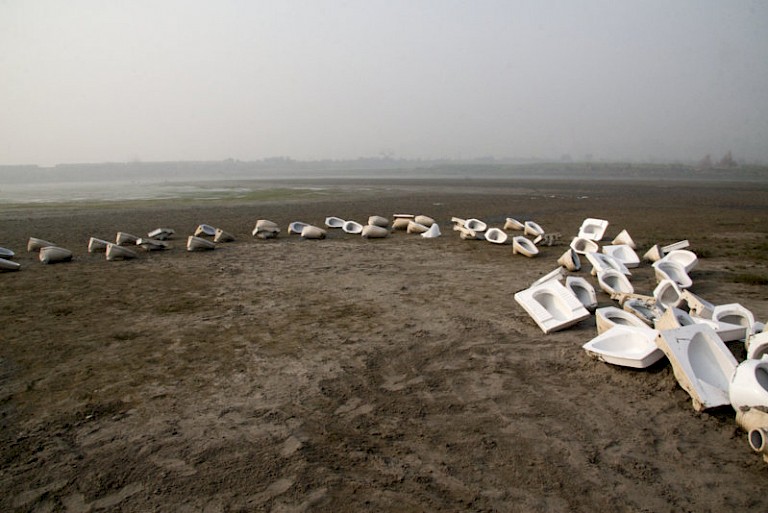
In the publication “Richard Long to Janet Cardiff – 40 years of Art Walking” Atul Bhalla’s walk is described as a photographic account of a five-day walk that the artist undertook along the banks of the Yamuna River which passes through his home town of New Delhi in India. It states “The 53 km walk reveals how the river shapes the life of the city across its different zones. The images include some grand projects of civic engineering – four-foot wide overland pipes built on a vast scale. They also include the most ramshackle or absurd constructions, including a temporary kitchen built (if that is the word) on top of the pipes.
Bhalla’s walk captures contrasting aspects of modern India in all its beauty and brutality. Waste and breathtaking beauty sit side by side. Indeed, the work begins with a photograph of a riverbank covered with litter. Bhalla alerts us to the contradictions of polluting the natural resource that allows the city to exist. He also alerts us to the fact that, while it has a sacred character in the culture, being associated with rituals of purification, it is also used for refuse disposal. The river is the primary symbol of the divine – and yet it is treated in ways which would suggest the opposite.”
Leon Tan provides further context:
“The Yamuna River takes its name from the Hindu Goddess Yamuna, daughter of the Sun God Surya and sister of the God of Death Yama. It flows through the city of Delhi and is the largest tributary river of India’s sacred Ganges. Legend has it that bathing in the Yamuna wards off death, or frees one from its torments. Ironically, it is the Yamuna itself that struggles for life today as it is one of the most polluted rivers in the world, receiving millions of liters of raw sewage per day along with countless liters of toxic chemical effluents from industrial and commercial activities. Perhaps because of its filthiness, the Yamuna barely exists in the awareness of Delhi’s millions of inhabitants, many of whom have never ever seen the river. In Delhi’s Mughal and British colonial periods, buildings used to be constructed with views of the Yamuna. Post-independence however, buildings adjacent to the river would inevitably be constructed facing away from it. One might say that a city had turned its back to its major waterway.
The significance of Atul Bhalla’s performative intervention Yamuna Walk (Through 22kms) is best appreciated against this backdrop. Invited to participate in KHOJ International Artists’ Association’s 2007 Eco+Art Residency, Bhalla conceived of the Yamuna Walk as a means of engaging residents of Delhi with the neglected river, documenting its conditions, and deepening his own relationship with both the city and river. The 22kms refers to the urban stretch of the Yamuna through Delhi, though the artist in fact walked a total of 56kms.
The journey proceeded from Palla village, the Yamuna’s point of entry into Delhi, through to Okhla Barrage, and out from the city into Uttar Pradesh. Where it was impossible to walk alongside the river, Bhalla resorted to taking a boat. The project began with a picnic at Jagatpur village, along the banks of the river. The site was chosen as one less littered than other parts of the river, and the event of a picnic, for the reason that “no one ever picnics on the river in Delhi. Picnickers came expecting a conventional “performance,” and instead were treated to refreshments and a boat ride.”
The project was also captured in the ‘Yamuna Walk’ photo book co-published by University of Washington Press and Sepia Eye, New York.
“Through his vivid and haunting photographs, Bhalla explores the myriad ways that modern life along the Yamuna is shaped by water, from the rural outskirts of the city to the polluted landscape of urban Delhi. Climbing over fences, crossing concrete overpasses, and navigating between blooming fields and piles of waste on his journeys, Bhalla also shows the diverse marks of human development that can be read in the image of the river… Bhalla describes his practice as an attempt to understand water, the way he perceives it, feels it, drinks it, swims in it, and sinks in it. The personal and humanized but still mysterious Yamuna that emerges through his photographs sheds an unusual and compelling light on issues of water and the urban environment.”
Credits
From Richard Long to Janet Cardiff - 40 years of Art Walking This publication accompanies the WALK-ON art exhibition. Walk On brings together works by artists of global repute, alongside works by some bright new talents and less well known names highlighting walking in both urban and rural settings. Curated by Cynthia Morrison-Bell & Alistair Robinson with the collaboration of Mike Collier and Janet Ross. Publication co organized by Northern Gallery of Contemporary Art and WALK Research Lab, University of Sunderland.
https://issuu.com/stereographic/docs/walkon_for_issuu
Leon Tan, Institute of Public Art
https://www.instituteforpublicart.org/case-studies/yamuna-walk/

